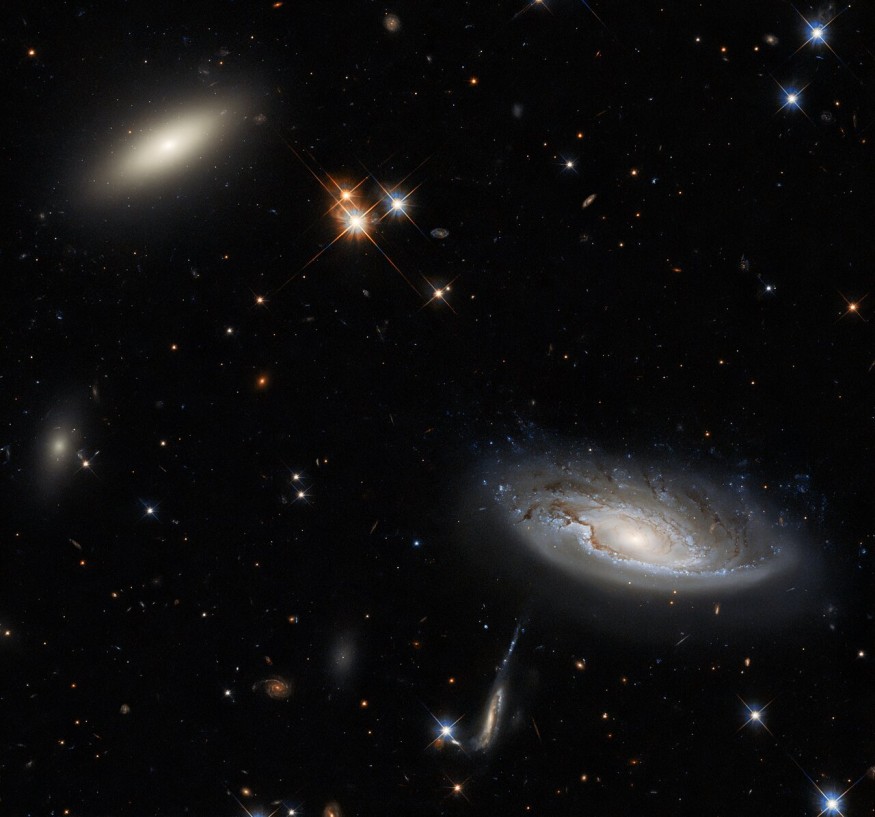The Perseus cluster contains dozens of massive galaxies that are around 240 million light-years from Earth. The Hubble Space Telescope of NASA/ESA acquired stunning images of the Perseus cluster.

Two Large Galaxies in the Perseus Cluster: 2MASX J03193743+4137580 and UGC 2665
Hubble's Wide Field Camera 3 (WFC3) recorded two highlights in the magnificent Picture of the Week, 2MASX J03193743+4137580 and UGC 2665, two large galaxies in the Perseus Cluster.
The galaxy on the left is 2MASX J03193743+4137580, a lenticular galaxy. To the other hand, the galaxy on the right is known as UGC 2665.
The two galaxies are around 350 million light-years apart from Earth, according to SciTechDaily. Both are then members of the massive Perseus galaxy cluster.
In Greek mythology, Perseus is a significant person. He is most famous for assassinating Medusa, the Gorgon. Then, for unknown reasons, he was cursed with having a live snake in his hair.
Given Perseus' remarkable qualifications, it is only fitting that the eponymous galaxy cluster is one of the universe's largest objects. Because it contains thousands of galaxies, only a few of which are visible in Hubble images.
Because of its high resolution, the photographs of massive galaxies in the Perseus cluster have incredible detail. Furthermore, WFC3 has a high sensitivity.
WFC3 is extremely light and infrared sensitive. As a result, it is possible to see the wavelengths collected in this photograph.
At other wavelengths, the Perseus supercluster appears to be quite different. Meanwhile, the space between galaxies looks to be dark and calm in Hubble's image. The Perseus cluster appears to burn with such tremendous brilliance when X-ray photons are viewed.
Brightest Star Cluster in the Sky
According to Space.com, there are almost 190 galaxies in the Perseus cluster's big galaxy. The Perseus-Pisces Supergugus is one among them. There are almost 1000 galaxies in the cluster.
NGC 1275 is also located in the galaxy's core. The source of radio transmitters and X-rays is a massive elliptical galaxy. When high X-ray emissions are found during aerobee flying, scientists are intrigued.
ALSO READ : Galaxy's 'No-Man's Land': Orphan Cloud Larger Than Milky Way Itself Discovered in Deep Space
When seen in the X-ray band, the Perseus cluster becomes the brightest in the sky and shifts crimson. The perseus cluster is the brightest in the sky, and its brightness corresponds to the optical point surrounding its center.
Then there is the seyfert's most powerful galaxy near the cluster's center. Large gas clouds with temperatures reaching millions of degrees can be seen in the Perseus cluster.
The radio's source was an extragalactic nebula in the constellation of Cygnus. Other investigations have suggested a link between the cluster's center and the probability of a collision between the two galaxies.
Clearly, the cause is the impact of relativistic matter from the cluster's center core on the galaxy's gaseous matter. In the cluster center, there is a radio source that blows relativistic plasma bubbles.
It appears as a hole in the cluster's X-ray picture. Because X-ray producing gases are pushed up by massive galaxies in the Perseus cluster.
Cluster Analysis of Perseus
SciNews said the Perseus cluster, which is around 11 million light-years away, is named for its host constellation. Abell 426 is another name for the cluster. One of the observable universe's most enormous things.
More than 1000 galaxies are encased in a massive cloud of gas. 2MASX J03193743+4137580 and UGC 2665 are two massive members of the Perseus cluster, as seen in the most recent Hubble pictures. UGC 2665 is a spiral galaxy, while 2MASX J03193743+4137580 is a lenticular galaxy.
The Perseus cluster is one of the most massive galaxies in the universe. Although galaxies in the center cluster region have been extensively studied, the research of galaxy populations in broader fields remains impressive.
The galaxy's study goal is brighter than the plane corresponding to the Perseus cluster's Abell radius. As a result, a new catalog has been created in a broad field around the Perseus cluster's center. The study will then look at the population of galaxies in detail, focusing on form and activity.
Eyeball inspection and surface brightness profile analysis provide morphological information. The researchers used SDSS spectrum archives, i.e. red-shift data from literature, to derive a low-resolution spectrum for big galaxies in the Perseus cluster.
RELATED ARTICLE : Are Black Holes Slowly Taking Over Star Cluster Palomar 5 Orbiting Milky Way Galaxy?
Check out more news and information on Space in Science Times.












